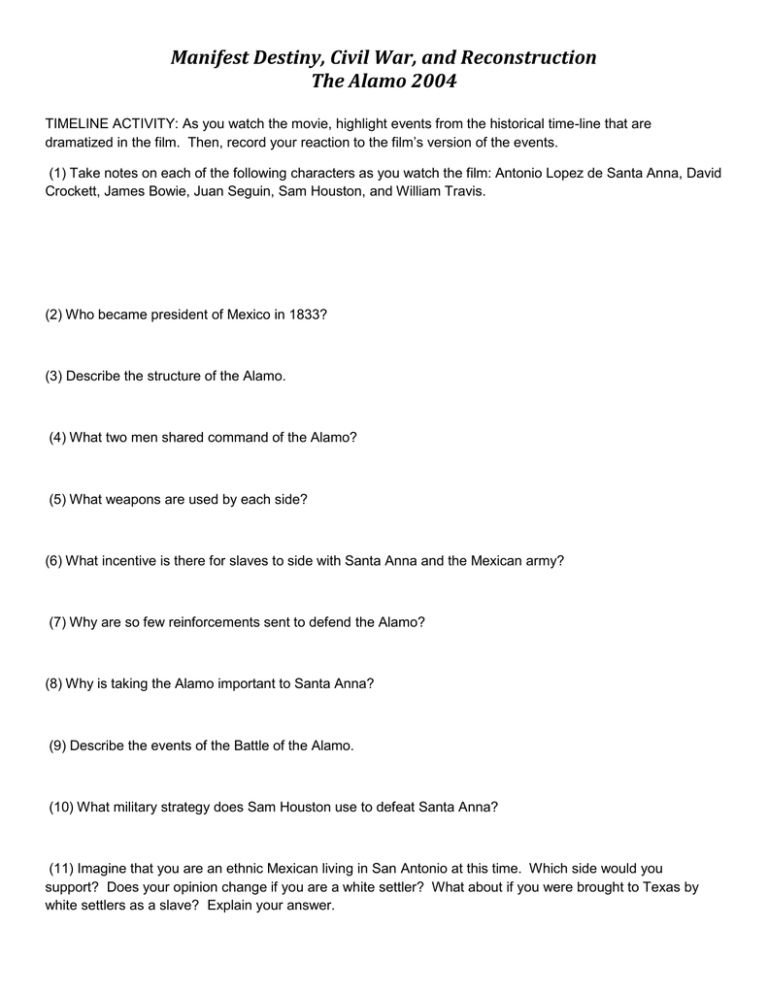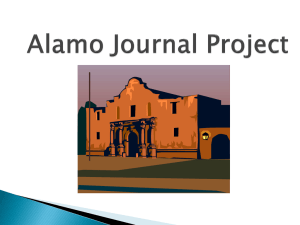The Alamo Questions and Time-line
advertisement

Manifest Destiny, Civil War, and Reconstruction The Alamo 2004 TIMELINE ACTIVITY: As you watch the movie, highlight events from the historical time-line that are dramatized in the film. Then, record your reaction to the film’s version of the events. (1) Take notes on each of the following characters as you watch the film: Antonio Lopez de Santa Anna, David Crockett, James Bowie, Juan Seguin, Sam Houston, and William Travis. (2) Who became president of Mexico in 1833? (3) Describe the structure of the Alamo. (4) What two men shared command of the Alamo? (5) What weapons are used by each side? (6) What incentive is there for slaves to side with Santa Anna and the Mexican army? (7) Why are so few reinforcements sent to defend the Alamo? (8) Why is taking the Alamo important to Santa Anna? (9) Describe the events of the Battle of the Alamo. (10) What military strategy does Sam Houston use to defeat Santa Anna? (11) Imagine that you are an ethnic Mexican living in San Antonio at this time. Which side would you support? Does your opinion change if you are a white settler? What about if you were brought to Texas by white settlers as a slave? Explain your answer. Manifest Destiny, Civil War, and Reconstruction The Alamo 2004 13 DAYS OF THE SIEGE OF THE ALAMO Day 1: Tuesday, February 23, 1836 General Antonio López de Santa Anna arrived in San Antonio that afternoon with the vanguard of his army. A blood-red banner was raised atop the bell tower of San Fernando Church, signifying that no prisoners would be taken. Colonel William B. Travis ordered a cannon fired in response. The Mexican soldiers fired back and the siege of the Alamo had begun. Day 2: Wednesday, February 24, 1836 Gravely ill, Colonel James Bowie turned over command of the volunteers to Colonel Travis. Travis sent Captain Albert Martin to Gonzales with a letter addressed "To the People of Texas and All Americans in the World." Day 3: Thursday, February 25, 1836 A messenger reached Colonel James W. Fannin at Goliad. In San Antonio, Santa Anna moved his batteries closer to the walls. A strong norther blew in that night around 9:00 P.M. Day 4: Friday, February 26, 1836 A skirmish occurred east of the fort when a group of Texans, who had left the Alamo to gather wood, encountered Mexican troops. The Mexican Army tried to cut the Alamo’s water supply. Day 5: Saturday, February 27, 1836 James Butler Bonham left the Alamo headed for Goliad and Gonzales. Back at the Alamo, nighttime activity by the Mexican Army kept the Texans on alert, allowing them very little sleep. Day 6: Sunday, February 28, 1836 Colonel Fannin left Goliad at the head of a relief column but turned back after only traveling a short distance. Mexican artillery fire fell in and around the Alamo throughout the day. Day 7: Monday, February 29, 1836 Santa Anna’s batteries moved still closer to the Alamo’s walls. The Mexican commander reviewed his troops. The Gonzales Ranging Company (32 men strong and commanded by Captain Albert Martin) left that town determined to reinforce the Alamo. [Note 1836 was a Leap Year.] Manifest Destiny, Civil War, and Reconstruction The Alamo 2004 Day 8: Tuesday, March 1, 1836 The Gonzales Ranging Company arrived at the Alamo at 3:00 a.m., raising hopes that others would soon follow. Texans fired two cannon shots at the house on Main Plaza occupied by Santa Anna--one hit the house but he was unharmed. Day 9: Wednesday, March 2, 1836 Heavy Mexican cannonading continued. Inside the Alamo, the defenders were unaware that delegates meeting at Washington-on-the-Brazos had signed the Texas Declaration of Independence. Day 10: Thursday, March 3, 1836 James Butler Bonham returned from Goliad to report that Colonel Fannin was not coming to the Alamo’s aid. Day 11: Friday, March 4, 1836 Mexican cannonading started early and continued all day. Day 12: Saturday, March 5, 1836 According to a popular legend, Colonel Travis drew a line on the ground with his sword and then asked those willing to stay and fight to cross over and join him. The Mexican bombardment ended at 10:00 p.m. Day 13: Sunday, March 6, 1836 1:00 a.m. The weary Texans slept while the Mexican troops moved into positions. 2:00 a.m. Santa Anna and Colonel Juan N. Almonte discussed the battle plans. 3:00 a.m. The Mexican troops were still moving into positions. 4:00 a.m. The troops, now in position, laid on the ground in silence. 5:00 a.m. Santa Anna gave the signal to advance just after 5 a.m. Four columns of Mexican troops advanced on the Alamo. Casualties on both sides mounted during the intense fighting. The troops scaled the north wall and poured into the compound. The fighting moved to the Long Barrack, Low Barrack, and former church. 6:30 a.m. THE ALAMO HAD FALLEN.



